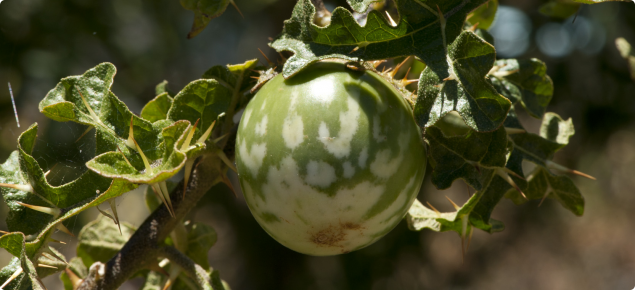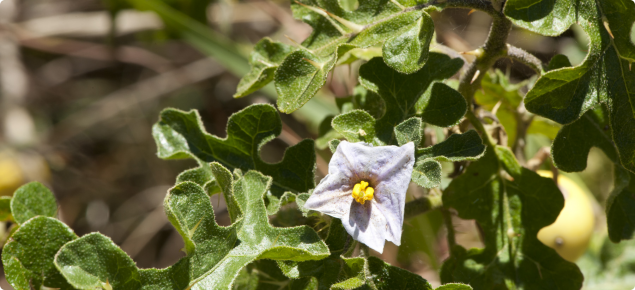Information about this pest can be found on the apple of Sodom: declared pest page.
Login or set up a new account on DPIRDs online training site to access:
- a training course on how to identify apple of Sodom and report it.
- training material that you can use to teach community groups how to identify apple of Sodom.
Chemical requirements
When using any agricultural chemicals please ensure that you always follow instructions on the label and any permit. Users of agricultural chemical products must always strictly comply with the directions on the label and the conditions of any permit. To view permits or product labels go to the Australian Pesticides and Veterinary Medicines Authority website.
Chemical control options
Chemical control options can be found below. For other methods of control please refer to the declared plant control handbook.
Recommended herbicides |
|
| Herbicide: Amitrole T® (Group F) | |
| Active ingredient | 250g/L amitrole + 220g/L ammonium thiocyanate |
| Rate of product | 1:100 |
| Rate of product/10L water | 100mL |
| Rate of Product/ha | Not recommended |
| Wetting agent | 1:600 |
| Time of application | Almost any time of year — spring and summer preferred |
| Remarks |
|
| Herbicide: Triclopyr (Group I) (various trade names: see APVMA link) | |
| Active ingredient |
|
| Rate of product/10L water |
|
| Rate of dilution for spot spraying | 1:300 |
| Time of application | When actively growing (spring - summer) |
| Wetting agent | 1:400 + summer spraying oil @ 1:400 may be used |
| Remarks |
|
| Herbicide: Glyphosate (Group M) (various trade names: see APVMA link) | |
| Active ingredient | 360, 490/500 and 540g/L, and 680g/kg glyphosate |
| Rates of dilution for spot spraying | 1:100 for 360g/L formulation |
| Rate of product/10L water |
Other concentrations of glyphosate available. Adjust rates if using them. |
| Rate of product/ha | Not recommended |
| Time of application | When actively growing spring, summer |
| Remarks |
|
| Herbicide: Picloram + 2,4-D amine (Group I) (various trade names: see APVMA link) | |
| Active ingredient | 75g/L picloram + 300g/L 2,4-D |
| Rate of dilution for spot spraying | 1:300 - 1:150 |
| Rate of product/10L water | 30mL - 65mL |
| Wetting agent | 1:400 |
| Time of application | Flowering to early fruiting |
| Remarks | Residual effects of picloram will persist for one to two seasons, depending on rates, affecting legumes but not grasses |





